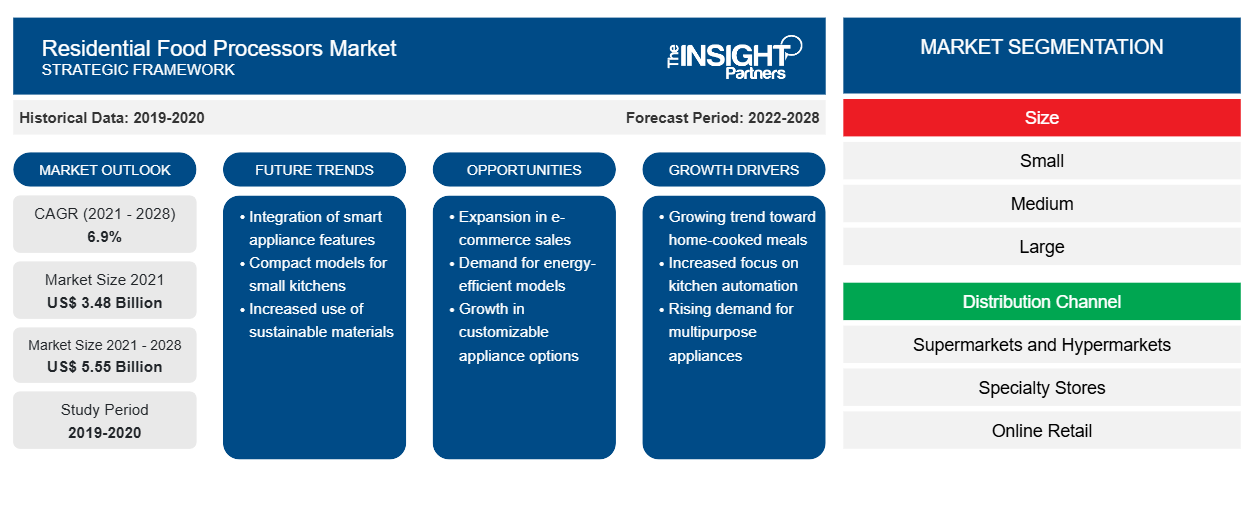家庭用フードプロセッサー市場は2021年に34億7,521万米ドルと評価され、2028年までに55億5,320万米ドルに達すると予測されており、 2021年から2028年にかけて6.9%のCAGRで成長すると予想されています。
家庭用フードプロセッサーは、基本的に、料理の準備中に繰り返し行う作業を楽にするためのキッチン家電です。最近のフードプロセッサーは、ほとんどが自動化されており、料理の準備が楽になります。
2020年には、アジア太平洋地域が世界の家庭用フードプロセッサー市場を支配し、予測期間中もその優位性を維持すると予想されています。地域全体の労働人口の増加により、便利な家庭用およびキッチン家電の需要が高まっています。これらの要因により、地域全体で家庭用フードプロセッサーの需要が促進されると予想されます。さらに、消費者のライフスタイルの変化により、近代化された家庭用およびキッチン家電の採用が増加しています。中国やインドなどの国では人口が増加しているため、キッチンスペースが限られた住宅や団地の建設が増加しています。そのため、ミニフードプロセッサーなどの小型キッチン家電の需要が増加しています。
要件に合わせてレポートをカスタマイズする
このレポートの一部、国レベルの分析、Excelデータパックなど、あらゆるレポートを無料でカスタマイズできます。また、スタートアップや大学向けのお得なオファーや割引もご利用いただけます。
-
このレポートの主要な市場動向を入手してください。この無料サンプルには、市場動向から見積もりや予測に至るまでのデータ分析が含まれます。
市場分析
便利な商品への需要増加
近年、仕事のプレッシャーが高まったため、消費者のライフスタイルは多忙になり、通常の勤務時間後には疲れを感じています。働くプロフェッショナルは、時間と労力を節約できる便利で自動化されたスマートな家庭用およびキッチン家電をますます好むようになっています。家庭用フードプロセッサーは多機能で高速です。これらのフードプロセッサーは、ユーザーが大勢の人のために料理をする場合でも、調理プロセスを効果的に大幅に楽にします。
サイズに関する洞察
家庭用フードプロセッサー市場は、サイズに基づいて、小型、中型、大型に分類されます。2020年には、中型セグメントが市場を支配しました。発展途上国でのキッチンのサイズとスペースの制約の増加は、中型家庭用フードプロセッサーの需要を促進する要因の1つです。中型家庭用フードプロセッサーには、中型スライスディスク、シュレッディングディスク、および処理用のステンレス鋼チョッピングブレードが含まれています。
Koninklijke Philips NV、Whirlpool Corporation、Breville Group Limited、De'Longhi Appliances Srl、Conair Corporation、Robert Bosch GmbH、MAGIMIX、SharkNinja Operating LLC、Groupe SEB、およびSpectrum Brands Inc.は、家庭用フードプロセッサー市場で活動している主要企業です。主要企業は、合併や買収、製品の発売など、地理的プレゼンスと顧客基盤を拡大するために、いくつかの戦略を採用しています。
家庭用食品加工機市場の地域別分析
予測期間を通じて住宅用食品加工機市場に影響を与える地域的な傾向と要因は、Insight Partners のアナリストによって徹底的に説明されています。このセクションでは、北米、ヨーロッパ、アジア太平洋、中東、アフリカ、南米、中米にわたる住宅用食品加工機市場のセグメントと地理についても説明します。

- 家庭用食品加工機市場の地域別データを入手
家庭用食品加工機市場レポートの範囲
| レポート属性 | 詳細 |
|---|---|
| 2021年の市場規模 | 34億8千万米ドル |
| 2028年までの市場規模 | 55億5千万米ドル |
| 世界のCAGR(2021年~2028年) | 6.9% |
| 履歴データ | 2019-2020 |
| 予測期間 | 2022-2028 |
| 対象セグメント |
サイズ別
|
| 対象地域と国 |
北米
|
| 市場リーダーと主要企業プロフィール |
|
家庭用食品加工機市場のプレーヤーの密度:ビジネスダイナミクスへの影響を理解する
家庭用食品加工機市場は、消費者の嗜好の変化、技術の進歩、製品の利点に対する認識の高まりなどの要因により、エンドユーザーの需要が高まり、急速に成長しています。需要が高まるにつれて、企業は提供品を拡大し、消費者のニーズを満たすために革新し、新たなトレンドを活用し、市場の成長をさらに促進しています。
市場プレーヤー密度とは、特定の市場または業界内で活動している企業または会社の分布を指します。これは、特定の市場スペースに、その規模または総市場価値と比較して、どれだけの競合相手 (市場プレーヤー) が存在するかを示します。
家庭用食品加工機市場で事業を展開している主要企業は次のとおりです。
- フィリップスNV
- ワールプールコーポレーション
- ブレヴィルグループリミテッド
- デ
免責事項:上記の企業は、特定の順序でランク付けされていません。

- 住宅用食品加工機市場のトップキープレーヤーの概要を入手
レポートの注目点
- 家庭用食品加工機業界の進歩的なトレンドは、プレーヤーが効果的な長期戦略を策定するのに役立ちます
- 先進国市場と発展途上国市場での成長を確保するために企業が採用する事業成長戦略
- 2019年から2028年までの世界の家庭用フードプロセッサー市場の定量分析
- さまざまな業界における家庭用フードプロセッサーの需要の推定
- 市場の成長を予測するために業界で活動しているバイヤーとサプライヤーの有効性を示すPEST分析
- 競争市場シナリオと家庭用フードプロセッサーの需要を理解するための最近の動向
- 家庭用フードプロセッサー市場の成長を牽引および抑制する要因と相まって、市場の動向と見通し
- 世界的な家庭用食品加工機市場の成長に関する商業的関心を支える戦略についての理解は、意思決定プロセスに役立ちます。
- 市場のさまざまなノードにおける家庭用食品加工機の市場規模
- 世界の家庭用フードプロセッサー市場の詳細な概要とセグメンテーション、およびその業界動向
- 有望な成長機会があるさまざまな地域の家庭用食品加工機の市場規模
「2028年までの世界の住宅用フードプロセッサー市場分析」は、世界の住宅用フードプロセッサー市場のトレンド分析に特に焦点を当てた、消費財業界の専門的かつ詳細な調査です。このレポートは、詳細な市場セグメンテーションで市場の概要を提供することを目的としています。住宅用フードプロセッサー市場は、規模、流通チャネル、および地理に基づいてセグメント化されています。規模に基づいて、市場は小規模、中規模、大規模にセグメント化されています。流通チャネルに基づいて、住宅用フードプロセッサー市場は、スーパーマーケットとハイパーマーケット、専門店、オンライン小売、その他にセグメント化されています。地理に基づいて、市場は北米、ヨーロッパ、アジア太平洋、中東およびアフリカ、南米および中米の5つの主要地域にセグメント化されています。
企業プロフィール
- フィリップスNV
- ワールプールコーポレーション
- ブレヴィルグループリミテッド
- デロンギアプライアンスSrl
- コンエアーコーポレーション
- ロバート・ボッシュ GmbH
- マジミックス
- シャークニンジャ オペレーティング LLC
- SEBグループ
- スペクトラムブランズ株式会社
- 過去2年間の分析、基準年、CAGRによる予測(7年間)
- PEST分析とSWOT分析
- 市場規模価値/数量 - 世界、地域、国
- 業界と競争環境
- Excel データセット
最新レポート
関連レポート
お客様の声
購入理由
- 情報に基づいた意思決定
- 市場動向の理解
- 競合分析
- 顧客インサイト
- 市場予測
- リスク軽減
- 戦略計画
- 投資の正当性
- 新興市場の特定
- マーケティング戦略の強化
- 業務効率の向上
- 規制動向への対応























 無料サンプルを入手 - 家庭用食品加工機市場
無料サンプルを入手 - 家庭用食品加工機市場